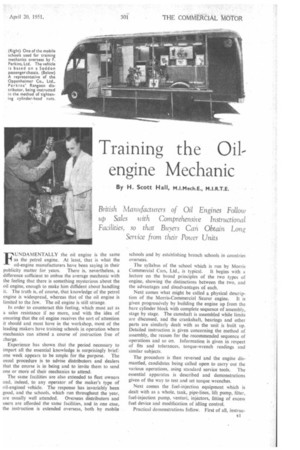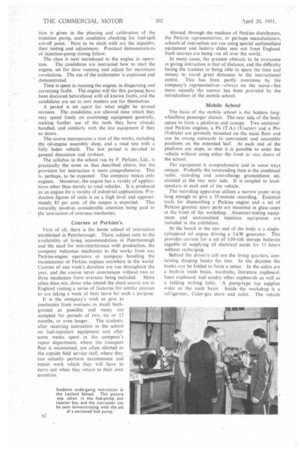Training the Oil engine Mechanic
Page 79

Page 80

Page 81

If you've noticed an error in this article please click here to report it so we can fix it.
By H. Scott Hall, M.I.Mech.E., M.I.R.T.E.
British Manufacturers of Oil Engines Follow Tip Sales with Comprehensive Instructional Facilities, so that Buyers Can Obtain Long Service from their Power Units FUNDAIVIENTALLY the oil engine is the same as the petrol engine. At least, that is what the oil-engine manufacturers have been saying in their
publicity matter for years. There is, nevertheless, a difference sufficient to imbue the average mechanic with the feeling that there is something mysterious about the oil engine, enough to make him diffident about handling it. The truth is, of course, that knowledge of the petrol engine is widespread, whereas that of the oil engine is limited to the few. The oil engine is still strange.
In order to counteract this feeling, which must act as a sales resistance if no more, and with the idea of ensuring that the oil engine receives the sort of attention it should and must have in the workshop, most of the leading makers have training schools in operation where mechanics can attend a course of instruction free of charge.
Experience has shown that the period necessary to impart all the essential knowledge is surprisingly brief: one week appears to be ample for the purpose. The usual procedure is to advise distributors and dealers that the course is in being and to invite them to send one or more of their mechanics to attend.
The same facilities are also extended to fleet owners and, indeed, to any operator of the maker's type of oil-engined vehicle. The response has invariably been good, and the schools, which run throughout the year, are usually well attended. Overseas distributors and users are afforded the same facilities, and in one case, the instruction is extended overseas, both by mobile
schools and by establishing branch schools in countries overseas.
The syllabus of the school which is run by Morris Commercial Cars, Ltd., is typical. It begins with a lecture on the broad principles of the two types of engine, showing the distinctions between the two, and the advantages and disadvantages of each.
Next comes what might be called a physical description of the Morris-Commercial Saurcr engine. It is given progressively by building the engine up from the bare cylinder block with complete sequence of assembly, stage by stage. The camshaft is assembled while limits are discussed, and the crankshaft, bearings and other parts are similarly dealt with as the unit is built up. Detailed instruction is given concerning the method of assembly, the reason for the recommended sequence of operations and so on. Information is given in respect of fits and tolerances, torque-wrench readings and similar subjects.
The procedure is then reversed and the engine dismantled, candidates being called upon to carry out the
various operations, using standard service tools. The essential apparatus is described and demonstrations given of the way to test and set torque wrenches.
Next comes the fuel-injection equipment which is dealt with as a whole, tank, pipe-lines, lift pump, filter, fuel-injection pump, venturi, injectors, fitting of excess fuel device and modification of idling control.
Practical demonstrations follow. First of all, instruc tion is given in the phasing and calibration of the injection pump, each candidate checking for fuel-spill cut-off point. Next to be dealt with are the injectOrs, their testing and adjustment. Practical demonstrations of injection-pump timing follow.
The class is next introduced to the engine in opera tion. The candidates are instructed how to start the engine, set for slow running and adjust for maximum revolutions. The use of the tachometer is explained and demonstrated.
Time is spent in running the engine, in diagnosing and correcting faults. The engine will for this purpose, have been doctored beforehand with all known faults, and the candidates are set to sort matters out for themselves.
A period is set apart for what might be termed revision. The candidates are allowed time which they may spend freely on examining equipment generally, making further use of the tools they have already handled, and similarly with the test equipment if they so desire.
The course incorporates a tour of the works, including the oil-engine assembly shop, and a road test with a fully laden vehicle. The last period is devoted to general discussion and revision.
The syllabus in the school run by F. Perkins, Ltd., is practically the same as that described above, but the., provision for instruction is more comprehensive. This is, perhaps, to be expected. The company makes only engines. Moreover, the engine has a variety of applications other than merely to road vehicles. It is produced as an engine for a variety of industrial applications. Production figures of units is on a high level and approxi mately 85 per cent, of the output is exported. This naturally involves considerable attention being paid to the instruction of overseas mechanics.
Courses at Perkins's
First of all, there is the home school of instruction established in Peterborough. There, subject only to the availability of living accommodation in Peterborough and the need for non-interference with production, the company welcomes mechanics to the works from any Perkins-engine operators or company handling the maintenance of Perkins engines anywhere in the world.
Courses of one week's duration are run throughout the year, and the course never commences without two or three mechanics from overseas being included. More often than not, those who attend the short course are in England visiting a series of factories for similar courses or are taking a week of their leave for such a purpose.
It is the company's wish to give to mechanics from overseas as much background as possible and many are accepted for periods of two, six or 12 months, or even longer. The students, after receiving instruction in the school on fuel-injection equipment and after some weeks spent in the company's
repair department, where the transport fleet is maintained, are often allotted to the outside field service staff, where they can actually perform maintenance and repair work which they will have to carry out when they return to their own countries. Abroad, through the medium of Perkins distributors, the Perkins representatives. or perhaps manufacturers, schools of instruction are run using special sectionalized equipment and lantern slides sent out from England. Such courses are being run all over the world.
In many cases, the greatest obstacle to be overcome in giving instruction is that of distance, and the difficulty facing the trainees in being able to spare the time and money to travel great distances to the instructional centre. This has been partly overcome by the company's representatives---always on the move—but more recently the answer has been provided by the introduction of the mobile school.
Mobile School The basis of the mobile school is the Seddon longwheelbase passenger chassis. The near side of the body opens to form a platform and canopy. Two sectionalized Perkins engines, a P6 (T.A.) (Tractor) and a P6v (Vehicle) are pivotally Mounted on the main floor and can be swung outwards to convenient and accessible positions on the extended leaf. At each end of the platform are steps, so that it is possible to enter the vehicle without using either the front or rear doors of the school.
The equipment is comprehensive and in some ways unique. Probably the outstanding item is the combined radio, recording and auto-change gramophone set, situated at the rear near side. It is coupled to loudspeakers at each end of the vehicle.
The recording apparatus utilizes a narrow paper strip long enough to give a 35-minute recording. Essential tools for dismantling a Perkins engine and a set of Perkins genuine spare parts are mounted in glass cases at the front of the workshop. Atomizer-testing equipment and sectionalized injection equipment are included in the exhibition.
At the bench in the rear end of the body is a singlecylindered oil engine driving a 34W generator. This provides current for a set of 110-volt storage batteries capable of supplying all electrical,needs for 11 hours svithout recharging.
Behind the driver's cab are the living quarters, containing sleeping bunks for two. In the daytime the hunks can be folded to form a settee. In the cabin are a built-in wash basin, wardrobe, literature cupboard, linen cupboard, and sundry other cupboards as well as a folding writing table. A pump-type tap supplies water to the wash basin. Inside the workshop is a refrigerator, Calor-gas stove and toilet. The vehicle
is heated throughout by Calor 'gas and the bodywork is insulated.
The attitude of Leyland Motors, Ltd., to the problem of instruction is somewhat different from those of Morris-Commercial and Perkins. In the first place, as is clearly stated in the official notes on the scope of the course, it is not intended to provide what could be looked upon as instruction in maintenance, and the lectures and instruction are confined to relevant items as applicable to the design and operation of the latest range of Leyland units.
The purpose is to analyse the principal features of individual units, and explanations are given of the object of design, the methods of manufacture and the primary points to be observed in maintenance in order to achieve optimum results over long periods. To facilitate this training, sectioned units are provided and test apparatus is included where necessary.
In the second place, although the course lasts only one week, it is designed to deal with the chassis as a whole and not merely the engine. The engine, however, is allotted the lion's share of the time available, two out of five days.
The syllabus provides first for the consideration of the power unit, description of its principal features and comparison of old and new engines. Next there is provision for examination and instruction on servicing of unit details, for example, the crankshaft and damper, bearings, pistons, liners and valves. The lubrication system is then dealt with.
On the next day, attention is directed to the injection equipment, with reference to the pump and governor construction, operation and maintenance. Now comes consideration of the injectors, their construction and maintenance, and after that fuels—suitability and cleanliness—and then filters.
The electrical equipment is dealt with next, and the principal features of the generator, starter motor and control board plug connectors and batteries are discussed. This part of the instruction terminates with a visit to the engine and chassis shops to inspect production and assembly
methods, with particular reference to the inspection
system.
A.C.V., Ltd., makes no special provision for instruction inasmuch as there is no school/in operation as has been described with reference to the other companies mentioned.
Visits to Works
Mechanics, either from the workshop of operators or from those concerns overseas who handle A.C.V. products, are invited to visit the works and to stay as long as they wish, within reason of course, and they may go into the shops and work with the mechanics engaged on servicing.
If circumstances be impracticable for those attending to stay more than a month, special efforts are taken to give them the maximum instruction in that time, but the company prefers that those attending the works for instructional purposes should stay longer than that, up to about six months or so.
The willingness of British oil-engine manufacturers to provide these facilities for the instruction of mechanics not only improves sales, but also cements goodwill between supplier and customer. Also, the training facilities enable operators to keep their engines in good order and attain maximum life—one of the chief reasons why British products are .chosen.








































































































































































































